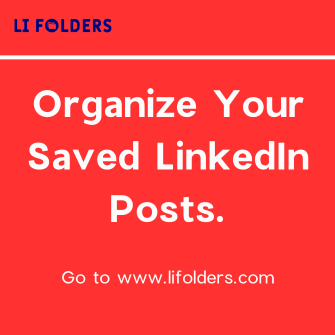
By bookmarking and organizing LinkedIn posts, you can unlock a treasure trove of industry insights, expert advice, and networking opportunities, effectively leveraging content from influencers like Richard van der Blom and creating a personalized repository of valuable information.
This reference library for professional development helps you stay informed about the latest developments in a rapidly changing business landscape.
ăm deployments utilizing frameworks like Ruby on Rails and Django.
To get the most out of saved posts, you'll need to manage them efficiently by creating folders and tags, regularly reviewing and organizing your saved items to avoid overload and ensure relevance to your career goals.
This efficient management prevents both overloading with excessive saves and neglecting regular clean-ups, ensuring that your saved posts remain a valuable resource over time.
By mastering these skills, you'll be able to harness the full potential of your saved posts and take your professional growth to the next level – and that's just the beginning of what you'll discover.
Why Save Posts on LinkedIn?

A Comprehensive Guide to LinkedIn Post Bookmarks and Organization
Why Save Posts on LinkedIn?
By bookmarking posts on LinkedIn, you're essentially building a personalized treasure trove of industry insights, trends, and expert advice that you can tap into whenever you need to stay informed or make informed decisions.
Saving posts on LinkedIn allows you to curate a personal reference library for professional development, helping you stay ahead of the curve in your industry.
You can gather industry news, trends, and analysis in one place, making it easier to stay informed about the latest developments, ensuring continuous learning and enhancing networking opportunities.
Managing Your Saved Posts
The efficient management of saved posts on LinkedIn is crucial for organizing and retrieving valuable content. Users can easily access and view all their saved posts through the 'Saved' tab on their profile. This central location allows for the creation of folders and the addition of tags to categorize saved posts, making it simple to find specific posts using the search bar and keywords.
Removing irrelevant posts helps maintain a focused library aligned with professional development goals. By properly organizing saved posts, users can construct a curated reference library that stays updated on industry trends and best practices, facilitating the quick location of essential information and the expansion of their professional network.
Common Mistakes to Avoid

While curating saved posts on LinkedIn, it's crucial to avoid common mistakes that can impede organization and productivity. One mistake is bookmarking an excessive number of posts, which can lead to clutter and make it difficult to locate specific content. Instead, be intentional about what you save and regularly review your bookmarks to ensure they remain relevant and aligned with your goals.
Another mistake is overlooking the importance of tags, a crucial aspect of content organization. Without proper categorization using relevant keywords, your saved posts can become disorganized and hard to navigate. Take the time to add relevant tags to keep things organized and easily accessible.
Additionally, don't rely solely on bookmarks; explore other LinkedIn features, such as folders, to further streamline your saved posts and enhance your overall user experience.
Maximizing Saved Post Engagement
By actively engaging with your saved posts on Instagram, you can unlock new opportunities for connection, conversation, and professional growth.
It's not enough to simply save Instagram posts; you need to interact with them to reap the benefits. Start by commenting on relevant content, sharing your own insights, or reaching out to the content creator. This helps to build relationships and establishes you as an active participant in your industry.
Additionally, offer value in your content by making it informative, visually appealing, and easy to consume, such as including recipes, cooking techniques, or other relevant information. Use relevant hashtags, collaborate with other influencers, and utilize Instagram Stories and Live Videos to further boost engagement and attract like-minded individuals who share your interests.
Organizing With Tags and Folders

You can supercharge your LinkedIn post bookmarks by leveraging tags and folders to categorize and retrieve your saved content with ease.
As a LinkedIn user, you're likely aware of the importance of staying organized and informed. By utilizing tags and folders, you can efficiently manage and access your saved posts, making it easier to stay on top of industry trends and make better contributions to discussions.
Use tags to categorize and label your saved posts by topics like 'Marketing Strategies' or 'Data Science,' and create folders as your personal filing cabinets to organize these tags. This way, you can quickly find the information you need, which is valuable to the article and helps you engage with your target audience more effectively.
Plus, with LinkedIn's privacy policy, you can rest assured that your feedback is private and protected under the LinkedIn User Agreement.
The Power of Curated Content
Curated content becomes a powerful tool in your professional arsenal when it's thoughtfully assembled and easily accessible, saving you time and providing direct access to valuable industry insights and trends.
By building a personal reference library with curated content, you'll enhance your professional knowledge and development, making you better equipped to show better contributions in your industry.
When you agree to LinkedIn's User Agreement, you're allowed to save posts that resonate with you, even if they're never shared publicly. This way, you can access valuable information that might be unhelpful if you find it through a random search. Use it to show that you're among the right people who stay updated on industry trends.
With technology on your side, organizing and accessing curated content is a breeze, making informed decision-making easier than ever.
Frequently Asked Questions
What Is the Best Way to Structure a Linkedin Post?
When structuring a LinkedIn post, you want to grab attention with a captivating headline that incorporates statistics, inspirational quotes, or thought-provoking questions.
Then, incorporate engaging visuals like images, videos, or infographics, along with concise language that uses pronouns and breaks up bulky paragraphs.
Utilize emojis to add emotional depth and color to your text.
To convey your message effectively, provide value to your audience by offering solutions, insights, or fun stories that resonate with their needs and interests.
Don't forget to include relevant hashtags, with 3-5 being the ideal number, and tag relevant individuals or organizations to boost visibility.
Finally, end with a strong call-to-action that encourages interaction and response.
What Should an Organization Post on Linkedin?
What should you post on LinkedIn?
Share industry news and trends to showcase your expertise, giving your audience valuable insights.
Humanize your organization by posting about company culture, employee spotlights, and behind-the-scenes content.
Promote your products, services, and events to drive engagement and conversions.
And, don't forget to mix in some interactive content, like polls and surveys, to encourage audience interaction.
What Are the Guidelines for Posting on Linkedin?
The guidelines for posting on LinkedIn include:
- Maintain a concise and visually appealing format using attention-grabbing headlines, incorporating relevant hashtags, and tagging relevant connections to increase post visibility.
- Conduct professional and respectful communication, ensuring content isn't misleading, fraudulent, obscene, threatening, discriminatory, or illegal.
- Ensure original content and avoid plagiarism: Only post content you have permission to share and own the rights to.
- Understand your end goal: Use LinkedIn strategically and understand how the algorithm prioritizes content, ensuring your posts align with your professional brand and industry.
- Publish a variety of content types, including articles, images, videos, and documents.
- Follow LinkedIn's publishing platform guidelines, which provide detailed specifications for writing and sharing effective content.
- Use engaging visuals: Banner images for articles are best at 600 x 322 pixels or 1200 x 644 pixels.
- Be mindful of the posting schedule: Post at least weekly to maintain visibility and choose posting times when your target audience is most active.
- Monitor success using LinkedIn Analytics: Track the performance of your posts and adjust your content and timing accordingly.
- Avoid posting job openings or promotional content, as these should be handled through LinkedIn's job posting features or advertising solutions.
What Shouldn't Linkedin Company Posts Include?
When crafting company posts on LinkedIn, what shouldn't you include?
Avoid sharing irrelevant or off-topic content, as it can dilute your professionalism and credibility. Steer clear of excessive hashtags, over-promotional language, and controversial or offensive content that can harm your brand reputation and alienate your audience.
Non-industry specific hashtags should also be avoided. Additionally, refrain from sharing personal opinions or political views, ignoring comments, and posting excessively. Ensure your posts align with your brand's values, mission, and target audience to maintain trust and authority.
Conclusion
You've mastered the art of saving and organizing posts on LinkedIn. With a system in place, you'll never miss a valuable insight or opportunity again.
Your curated content will shine, and engagement will soar. You're now a LinkedIn pro, equipped to stay ahead of the curve and make meaningful connections.






